Best eSIM for Australia in 2025
Heading to Australia? We've gathered the best eSIM card providers to make sure you have internet on your phone the whole time.

Australia is a major tourist and business destination, with over 7 million foreign visitors. When visiting Australia, you’ll need an internet connection to post those fun videos, keep in touch with friends and family, and generally stay connected to the world.
The best eSIMs for international travel should make it easy to get this internet connection.
You can purchase and activate an eSIM outside Australia and get speedy internet access once you land at the airport. Many eSIM providers offer packages in Australia, and it can be challenging to find the best ones, at least due to choice overload.
We’re here to help, and we’ve curated the best eSIM providers for Australian visitors. We conducted extensive research and testing to select the best providers based on affordability, coverage, and speed. Affordability was the primary criterion, as we want our readers to get the most for their money.
Get a 7-day free trial for GigSky eSIM
GigSky eSIM offers coverage in over 200 countries, plus dedicated cruise and in-flight plans for seamless connectivity wherever you travel. With flexible data packages, reliable global coverage, and instant activation, GigSky makes it easy to stay connected without roaming hassles.
TechRadar Pro Approved Sponsored Offer
The best eSIMs for Australia of 2025 in full:
Why you can trust TechRadar
Best eSIM overall
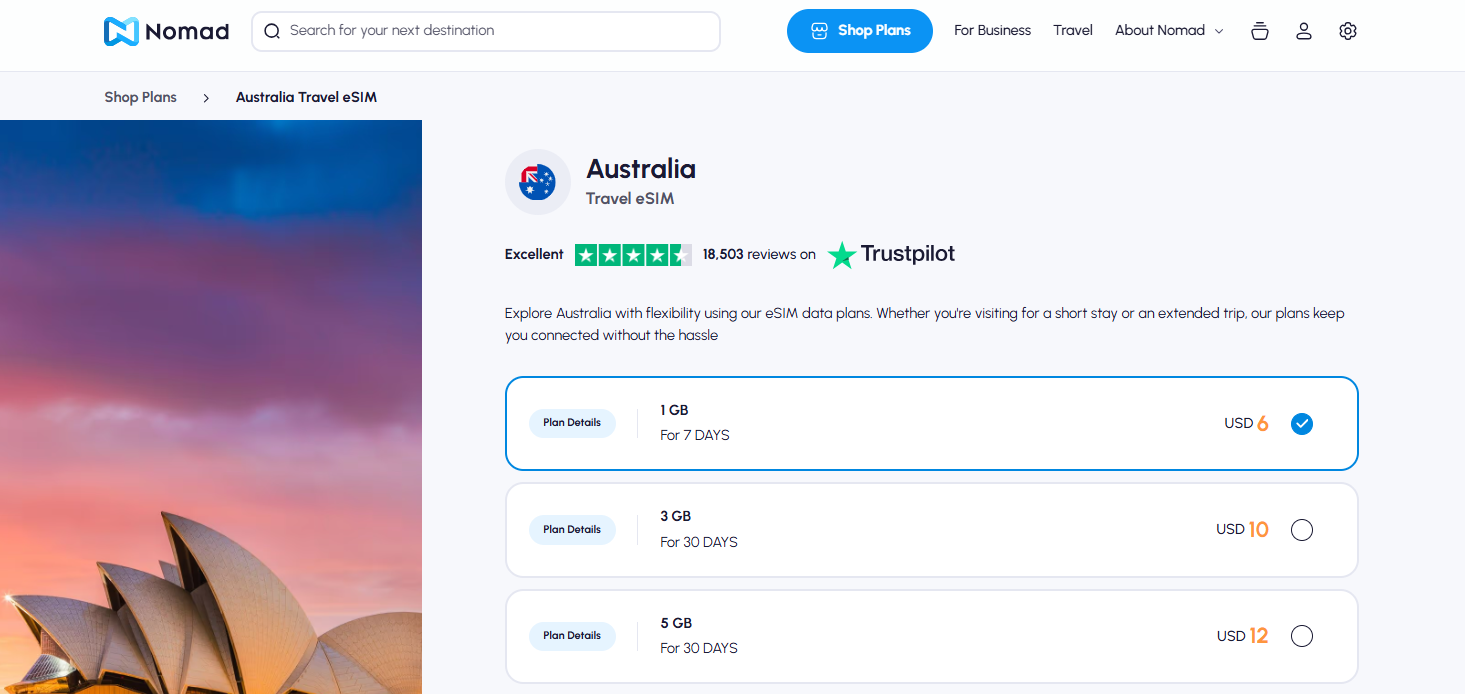
Specifications
Reasons to buy
Reasons to avoid
Nomad is an eSIM provider famous for its affordable plans, and it doesn’t disappoint in Australia. It offers different packages, including $6 for 1 GB for 7 days, $10 for 3 GB for 30 days, $12 for 5 GB for 30 days, $19 for 10 GB for 30 days, $20 for 15 GB for 30 days, $30 for a 20 GB 45-day plan, and $55 for a 50 GB 45-day plan.
Nomad also offers unlimited plans for Australian visitors, but there is a catch. You can choose plans that provide between 500 MB and 3 GB of daily browsing; after surpassing this daily limit, your browsing speed will be throttled to 512 kbps until the next day.
The unlimited plans are flexible. You can choose your desired daily data allocation for one day, three days, five days, seven days, or ten days. For example, the 3-day plan costs $11 and the 10-day plan costs $25.
Nomad uses Telstra and Optus as its backbone networks in Australia. These are the country's first and second-largest mobile carriers, providing robust coverage even in remote areas. 5G is easily accessible in urban centers but might not be available in remote areas.
Read our full Nomad review.
Best eSIM for regional plans
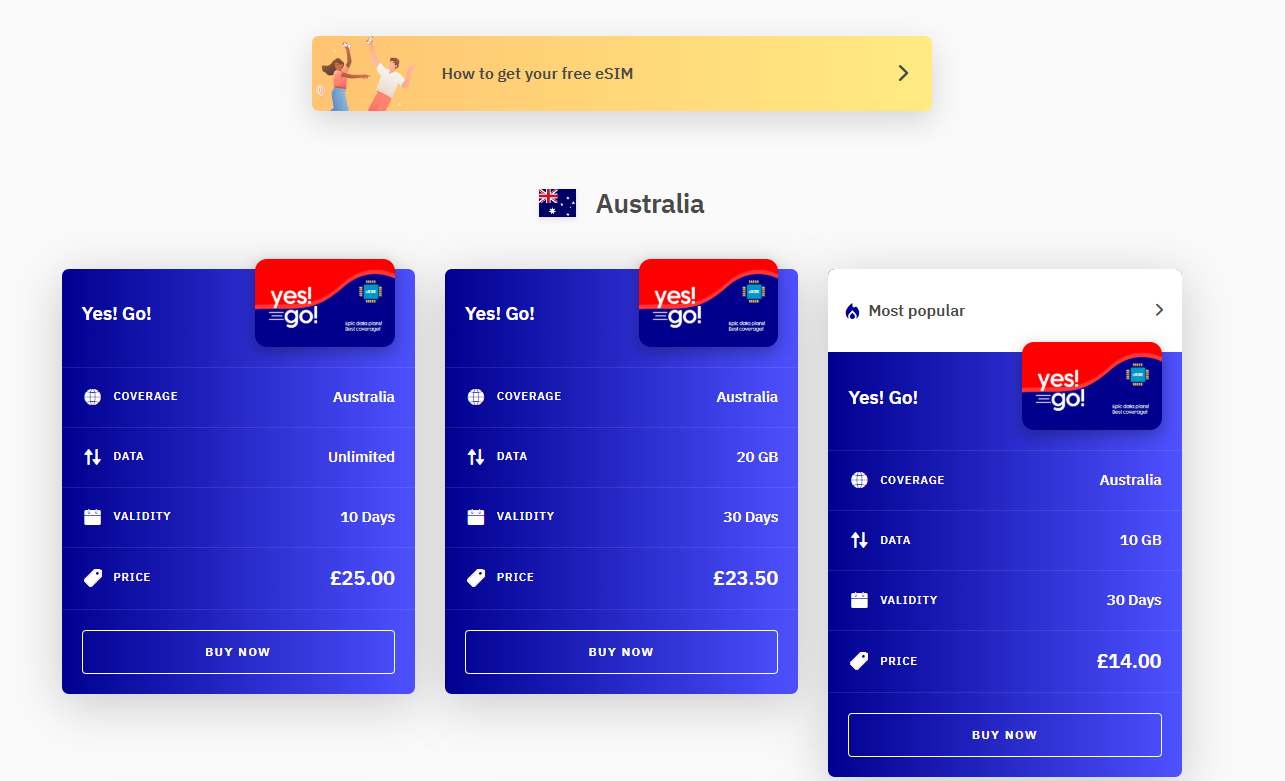
Specifications
Reasons to buy
Reasons to avoid
Airalo offers a diverse range of eSIM plans for Australian visitors. These include $3.50 for 1 GB for 7 days, $6.50 for 2 GB for 15 days, $7 for 3 GB for 30 days, $8.50 for 5 GB for 30 days, $14 for 10 GB for 30 days, and $23.50 for 20 GB for 30 days.
This eSIM provider also offers robust regional plans. Its Asialink plans cover Australia and seven nearby territories: Fiji, New Zealand, Nauru, Papua New Guinea, Samoa, Tonga, and Vanuatu.
Airalo uses Telstra, Opus, and Vodafone as its backbone networks in Australia. These carriers provide robust 4G and 5G coverage across the country, including in remote regions. While 5G might be inaccessible in remote areas, it is easy to find in populated centers.
We like Airalo’s cost-effective regional plans. We recommend them to anyone visiting Australia and nearby destinations like New Zealand and Papua New Guinea. With these plans, you can use the same eSIM to get reliable internet connections across all your destinations.
We have an exclusive code from Airalo- use code FUTURE15 to get 15% off on all eSIM plans.
Read our full Airalo review.
Best eSIM for security
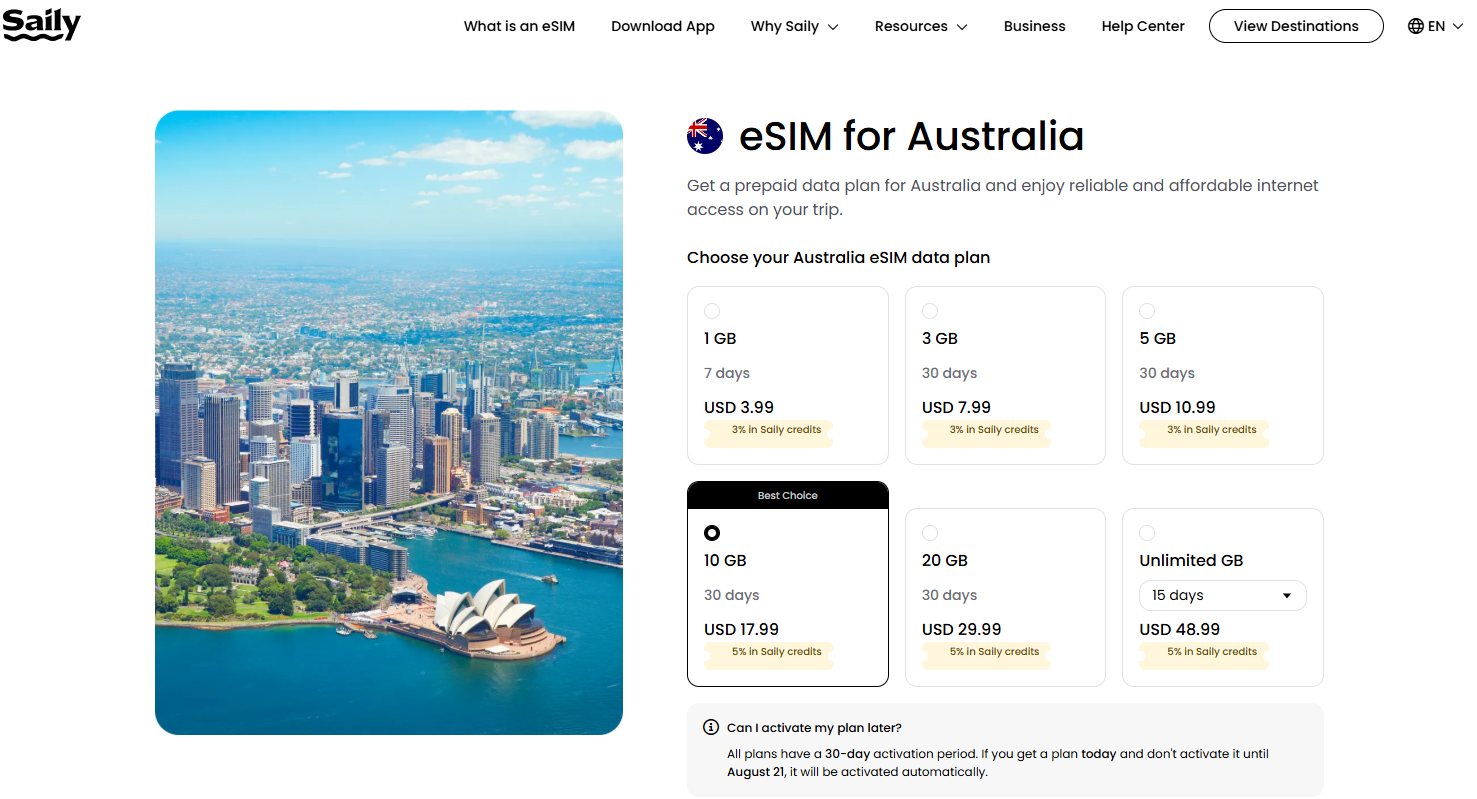
Specifications
Reasons to buy
Reasons to avoid
Saily is an eSIM provider owned by NordVPN, a popular VPN software company. It offers affordable eSIM plans for global destinations, including Australia.
Its plans include $4 for 1 GB for 7 days, $8 for 3 GB for 30 days, $11 for 5 GB for 30 days, $18 for 10 GB for 30 days, and $30 for 20 GB for 30 days. There is one unlimited plan available for 15 days and costs $49.
Saily’s plans aren’t as diverse and flexible as those of other providers like Holafly and Airalo. However, they offer a good bang for your buck. It’s an ideal eSIM provider if you need a low-tier plan for a few days’ visit to Australia.
And if you want that extra blanket of security, then Saily is the perfect choice. Users can benefit from features like web protection, virtual location, and ad blockers. For instance, by turning on the virtual location feature in the app, you can select your location anywhere in the world. The CEO of Saily tells us more on how the company is reshaping the travel tech space.
This eSIM provider has one of the most intuitive apps we’ve encountered. You can use this app to seamlessly purchase and activate your eSIM package.
Saily relies on leading Australian networks like Optus and Telstra, which provide users with excellent coverage and speed across the country.
Use our exclusive code Techradar5 on Saily to get 5% off on all eSIM plans.
Read our full Saily review.
Best eSIM for customer service
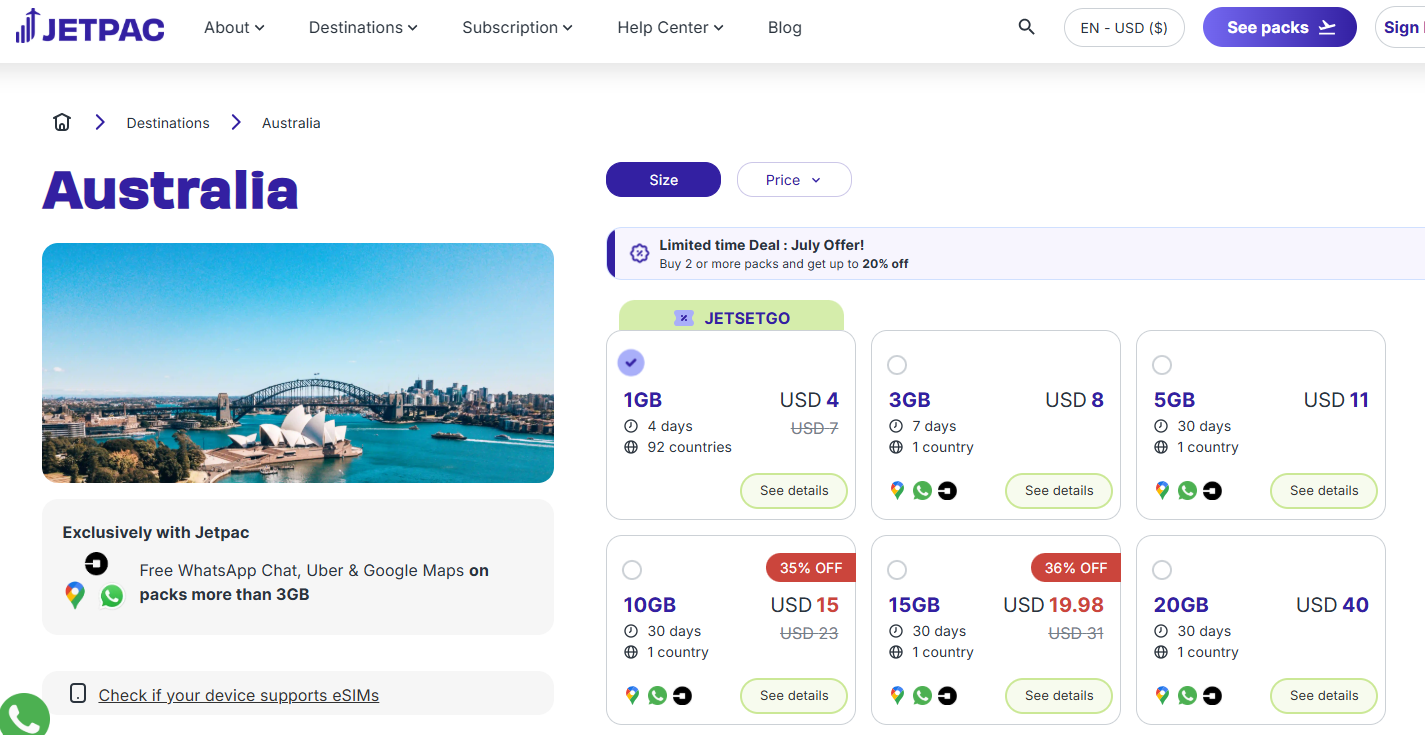
Specifications
Reasons to buy
Reasons to avoid
Jetpac offers affordable eSIM plans for Australian visitors. These include $8 for 3 GB for 7 days, $11 for 5 GB for 30 days, $23 for 10 GB for 30 days, $31 for 15 GB for 30 days, $40 for 20 GB for 30 days, $55 for 30 GB for 30 days, and $75 for a 40 GB 30-day plan.
The unlimited plans are bundled up with other countries and cost $34.99 for 7 days and $50.99 for 10 days.
While we like the perks Jetpac offers, like airport lounge access, the plans are costlier than its counterparts. For instance, Jetpac's 20GB plan is $40, while Airalo offers that for half the price.
However, the eSIM provider frequently runs promos, enabling customers to get the above packages at significantly discounted prices. It also offers a unique 1 For 1 package for new subscribers, giving a 1 GB 4-day plan for just $1.
Jetpac uses Optus and Telstra as its foundational networks in Australia. Customers can connect to these local carriers’ infrastructure and access speedy internet coverage across Australia.
You can buy and activate an eSIM from Jetpac’s website or mobile app. The user-friendly mobile apps are available on iOS and Android. These apps let you monitor your usage and buy more data if needed.
Read our full Jetpac review.
Best eSIM for unlimited plans
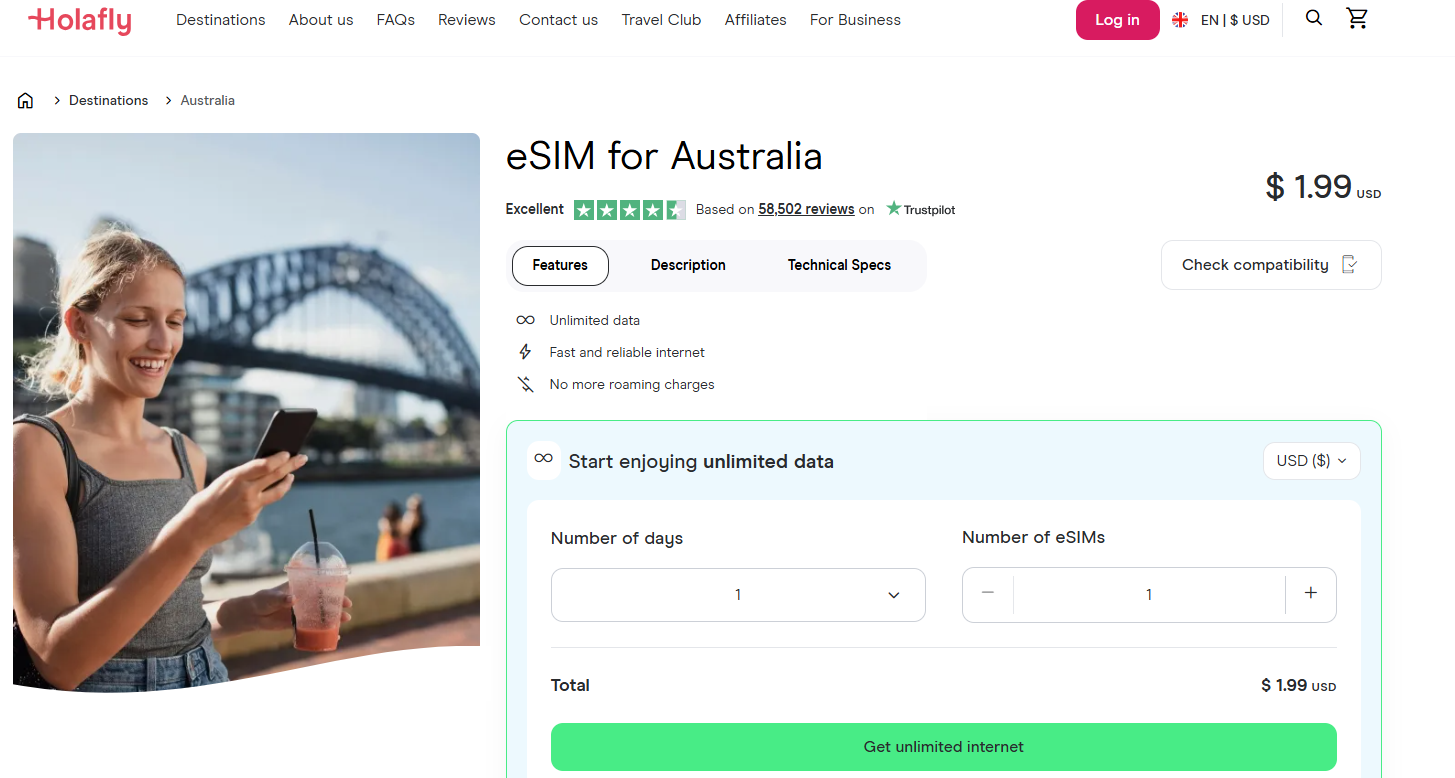
Specifications
Reasons to buy
Reasons to avoid
Holafly offers unlimited data plans for Australian visitors. Unlike other providers with fixed-duration plans, its plans are flexible, allowing you to choose any number of days from 1 to 90.
For instance, one day of unlimited data costs $1.99, 5 days cost $21, 15 days cost $51, 30 days cost $75, and 90 days cost $140. The longer the days, the more cost-effective the plan.
We recommend Holafly for heavy internet users who frequently stream or download online content. It’s a cost-efficient way to enjoy reliable internet access across Australia. Holafly allows you to share your data via a hotspot, but sharing is limited to 500 MB daily.
Note that fair usage policies apply, so the plans aren’t 100% “unlimited.” Australian carriers have limits after which your browsing speed gets throttled. However, these limits are too high for most users to reach, so you’ll be fine, except you plan to consume several terabytes of data monthly.
Holafly works with Optus and Telstra as its partner networks in Australia. You can enjoy stellar 5G coverage across Sydney, Perth, Adelaide, Brisbane, and other touristy areas of Australia.
We've partnered with Holalfy to bring you an exclusive offer- use code TECHRADAR to get 5% off.
Read our full Holafly review.
Best eSIM for ease-of-use
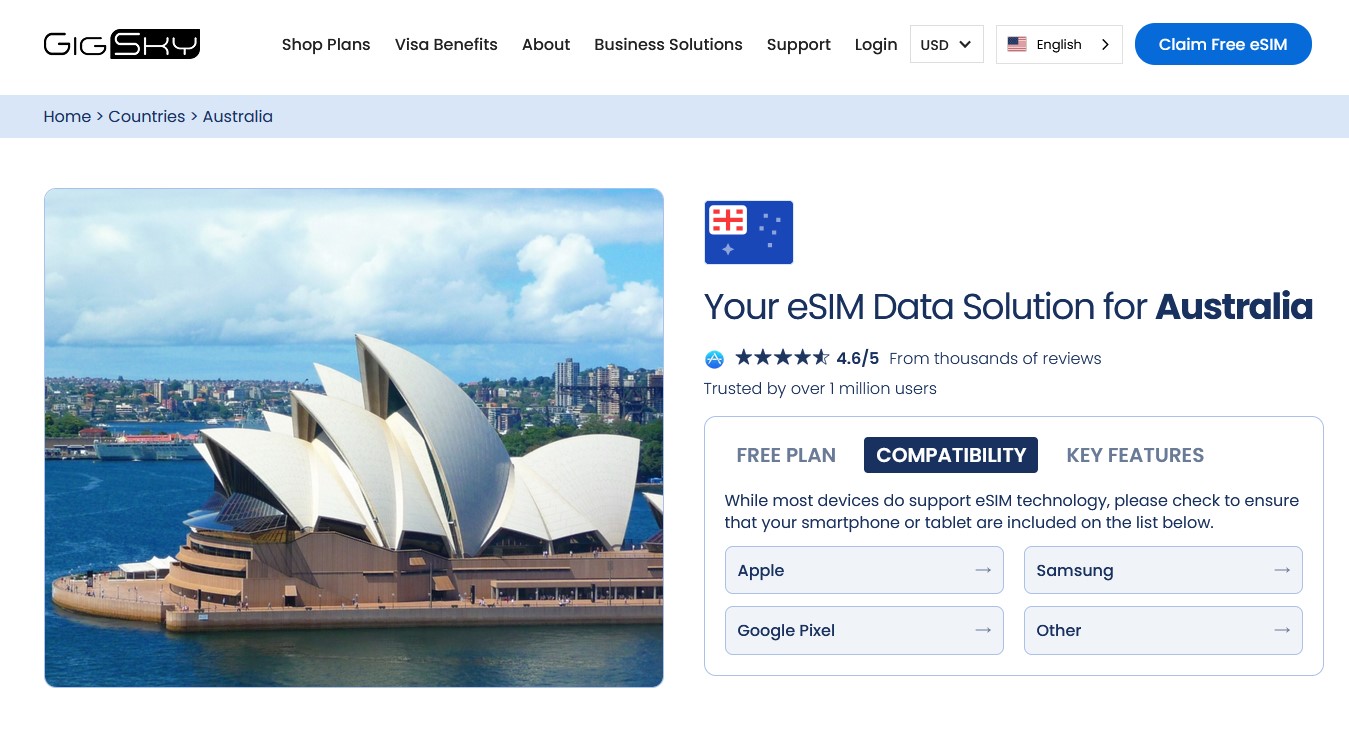
Specifications
Reasons to buy
Reasons to avoid
An international service with over 400 partners around the world, GigSky is a good choice for anyone wanting to travel to Australia. The service offers a variety of data plans, both fixed and unlimited. There’s also a 100MB free trial for 7 days.
The starting fixed data plan is priced at $4.99 for 1GB and 7 days. The highest amount of data you can get is 100GB for 180 days, and that is priced at $105.39. If you prefer unlimited data, the pricing starts at $4.99 for 1 day, going all the way to $63.74 for 30 days. There are also regional plans available for the Asia-Pacific region.
GigSky offers 5G connectivity, but phone calls or SMS aren’t supported at all (you can use VoIP apps, though). The service will slow your speed on unlimited data plans after you spend 2.5GB per day, although your data will never be capped.
GigSky supports Android and iOS, and has 24/7 customer support.
The installation itself is a breeze, where you’ll only need a few minutes to get it all sorted. Get the app, make an account, choose a destination and the data plan, and you’re then ready to activate your eSIM.
If for any reason you ever need help, you can contact GigSky through email or directly via its apps. You may also want to check out the FAQ section and Help Center, as there is helpful information there, as well.
Read our full GigSky review.
Best eSIM for Australia FAQs
What is an eSIM?
An eSIM (embedded SIM) is a digital version of a SIM card. It’s a reprogrammable chip embedded directly in a smartphone. Hence, you can change your eSIM virtually without swapping any physical cards.
eSIMs have become popular because of their convenience and security, and we have seen global eSIM shipment volume surpassing half a million units earlier this year, indicating the growing demand.
You can install an eSIM from anywhere without swapping any physical components. eSIMs are secure because there is no card to remove if your smartphone is misplaced.
An eSIM is the best option for accessing the internet when visiting foreign countries. You can buy and activate an eSIM in your home country and then enjoy internet access once you arrive in Australia. An eSIM removes the need to visit any office or shop for a SIM swap after landing in Australia.
eSIM providers like Nomad and Airalo have partnerships with domestic telecom firms in various countries. When you visit any supported country, you can connect to the local carriers’ infrastructure to access the internet.
Can I get 5G access with an eSIM in Australia?
Yes, many eSIM providers offer 5G access in Australia, thanks to the country’s ubiquitous telecoms infrastructure. Australia was one of the earliest 5G adopters, with Optus and Telstra offering 5G access starting in 2019. 85% of Australia had 5G access as of 2024, and this coverage is expected to reach 95% by mid-2025.
5G access isn’t a problem in urban centers like Sydney, Melbourne, and Perth. These areas have built-up infrastructure that offers ultrafast speed to residents and visitors. However, some remote areas lack 5G access.
Does my eSIM include a phone number?
Most eSIM providers don’t offer a phone number because of the regulatory and infrastructural complexities associated with this service.
Telecom is a strictly regulated industry wherein firms must obtain permits to issue phone numbers for calls and SMS messages. These permits are usually only granted to local firms and have high maintenance costs.
Airalo, Holafly, Nomad, and other eSIM providers don’t offer phone numbers because of the high cost and regulatory barriers. Instead, they partner with domestic carriers across different countries to provide data-only services.
If you need an eSIM with a phone number, you’ll have to visit a local carrier’s office in Australia. Receiving an Australian phone number requires valid identification, unlike eSIM data packages that anyone can activate without providing personal information.
Can I access public WiFi in Australia?
eSIM plans are often limited, so it’s understandable that many seek to minimize their usage and use WiFi for heavy browsing activities. The good thing is that public WiFi is easy to access in Australia, especially in urban centers.
Your hotel or hostel will likely offer a WiFi connection, so you can confirm this when checking in. Many cafes, restaurants, and public libraries offer free WiFi, so you can ask about this when visiting these establishments.
Most establishments don’t explicitly advertise their free WiFi, so you’ll likely need to inquire to access this service. Beware of security vulnerabilities when accessing public WiFi networks, as some networks are insecure and are major hacking targets.
Switching on your VPN service when using public Wi-Fi networks can mitigate security threats. VPNs encrypt your browsing identity and shield your online activity from prying eyes.
How can I install my eSIM?
Most eSIM providers have similar installation processes. After paying, you can install an eSIM via your provider’s app or scan a QR code sent to your email address.
Installing an eSIM requires following the provider's on-screen instructions. It’s a simple process you can handle in a few minutes. You can install the eSIM outside Australia and connect to the internet once you land there.
However, before you purchase any eSIM, make sure that your smartphone is eSIM compatible. Learn more about how to check if your phone supports eSIM in our detailed guide.
How we tested the best eSIMs for Australia
We tested the best eSIMs for Australia by evaluating numerous factors. To start with, we looked at how easy the setup is, if the app is intuitive, and the connectivity and reliability of the service. We also compared data plans.
We carried out the tests using both iPhone and Android phone models in order to gauge whether the experience was the same for each, or whether one type had a greater advantage over the other. We then compared the overall results to draw up our list.
Read more on how we test, rate, and review products on TechRadar.
- You've reached the end of the page. Jump back up to the top ^
Sign up to the TechRadar Pro newsletter to get all the top news, opinion, features and guidance your business needs to succeed!
Stefan has always been a lover of tech. He graduated with an MSc in geological engineering but soon discovered he had a knack for writing instead. So he decided to combine his newfound and life-long passions to become a technology writer. As a freelance content writer, Stefan can break down complex technological topics, making them easily digestible for the lay audience.
- Sead Fadilpašić
- Udita ChoudharyContent Sub Editor

